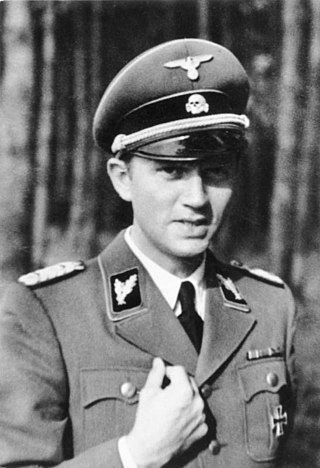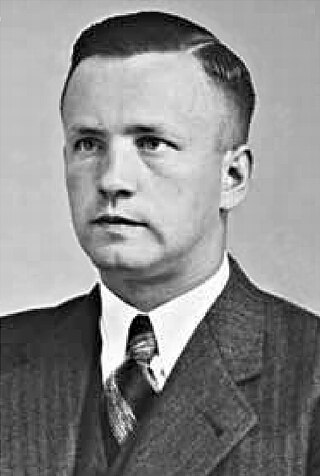Related Research Articles
Sicherheitsdienst, full title Sicherheitsdienst des Reichsführers-SS, or SD, was the intelligence agency of the SS and the Nazi Party in Nazi Germany. Established in 1931, the SD was the first Nazi intelligence organization and the Gestapo was considered its sister organization through the integration of SS members and operational procedures. The SD was administered as an independent SS office between 1933 and 1939. That year, the SD was transferred over to the Reich Security Main Office, as one of its seven departments. Its first director, Reinhard Heydrich, intended for the SD to bring every single individual within the Third Reich's reach under "continuous supervision".

MI5, officially the Security Service, is the United Kingdom's domestic counter-intelligence and security agency and is part of its intelligence machinery alongside the Secret Intelligence Service (MI6), Government Communications Headquarters (GCHQ), and Defence Intelligence (DI). MI5 is directed by the Joint Intelligence Committee (JIC), and the service is bound by the Security Service Act 1989. The service is directed to protect British parliamentary democracy and economic interests and to counter terrorism and espionage within the United Kingdom (UK). Within the civil service community, the service is colloquially known as Box, or Box 500, after its official wartime address of PO Box 500; its current address is PO Box 3255, London SW1P 1AE.

Leopold Zakharovich Trepper was a Polish-Israeli Communist and career Soviet agent of the Red Army Intelligence. With the code name Otto, Trepper had worked with the Red Army since 1930. He was also a resistance fighter and journalist.

Walter Friedrich Schellenberg was a German SS functionary during the Nazi era. He rose through the ranks of the SS, becoming one of the highest ranking men in the Sicherheitsdienst (SD) and eventually assumed the position as head of foreign intelligence for Nazi Germany following the abolition of the Abwehr in 1944.

The Red Orchestra was the name given by the Abwehr Section III.F to anti-Nazi resistance workers in Germany in August 1941. It primarily referred to a loose network of resistance groups, connected through personal contacts, uniting hundreds of opponents of the Nazi regime. These included groups of friends who held discussions that were centred on Harro Schulze-Boysen, Adam Kuckhoff and Arvid Harnack in Berlin, alongside many others. They printed and distributed prohibited leaflets, posters, and stickers, hoping to incite civil disobedience. They aided Jews and resistance to escape the regime, documented the atrocities of the Nazis, and transmitted military intelligence to the Allies. Contrary to legend, the Red Orchestra was neither directed by Soviet communists nor under a single leadership. It was a network of groups and individuals, often operating independently. To date, about 400 members are known by name.

Heinrich Müller was a high-ranking German Schutzstaffel (SS) and police official during the Nazi era. For most of World War II in Europe, he was the chief of the Gestapo, the secret state police of Nazi Germany. Müller was central in the planning and execution of the Holocaust and attended the January 1942 Wannsee Conference, which formalised plans for deportation and genocide of all Jews in German-occupied Europe—The "Final Solution to the Jewish Question". He was known as "Gestapo Müller" to distinguish him from another SS general named Heinrich Müller.

Heinrich Koenen was a German engineer, anti-fascist resistance fighter and agent of the Soviet military intelligence service GRU, known as a "scout".

Franz Josef Huber was an SS functionary who was a police and security service official in both the Weimar Republic and Nazi Germany. Huber joined the Nazi Party in 1937 and worked closely with Gestapo chief Heinrich Müller. After the German annexation of Austria in 1938, Huber was posted to Vienna, where he was appointed chief of the Security Police (SiPo) and Gestapo for Vienna, the "Lower Danube" and "Upper Danube" regions. He was responsible for mass deportations of Jews from the area. After the war ended, Huber never served any prison time. He was employed by the West German Federal Intelligence Service from 1955–64. He died in Munich in 1975.

The Secret Intelligence Service (SIS), commonly known as MI6, is the foreign intelligence service of the United Kingdom, tasked mainly with the covert overseas collection and analysis of human intelligence on foreign nationals in support of its Five Eyes partners. SIS is one of the British intelligence agencies and the Chief of the Secret Intelligence Service ("C") is directly accountable to the Foreign Secretary.

Friedrich Panzinger was a German SS officer during the Nazi era. He served as the head of the Reich Security Main Office (RSHA) Amt IV A, from September 1943 to May 1944 and the commanding officer of three sub-group Einsatzkommando of Einsatzgruppen A in the Baltic States and Belarus. From 15 August 1944 forward, he was chief of RSHA Amt V, the Kriminalpolizei. After the war, Panzinger was arrested in 1946 and imprisoned by the Soviet Union for being a war criminal. Released in 1955, he was a member of the Bundesnachrichtendienst. In 1959, Panzinger committed suicide in his jail cell after being arrested for war crimes.
Rita Arnould was a housekeeper and courier of the Red Orchestra resistance group in Belgium during World War II. She was captured when the Funkabwehr raided an apartment at 101 Rue des Atrébates in Brussels on 12 December 1941 at 2 pm. from which a Soviet clandestine radio station was being run.

Heinz Michael Pannwitz was a German war criminal, Nazi Gestapo officer and later Schutzstaffel (SS) officer. Pannwitz was most notable for directing the investigation into the assassination of Obergruppenführer Reinhard Heydrich on 27 May 1942 in Prague. In the last two years of the war, Pannwitz ran the Sonderkommando Rote Kapelle, a combined Abwehr and Gestapo counterintelligence operation against the Red Orchestra espionage network, in France and the Low Countries.

Horst Heilmann was a German resistance fighter against the Nazi regime. He was a member of the anti-fascist resistance group that formed around Harro Schulze-Boysen in 1940. Later, the people of the group along with many others were bundled together and called the Red Orchestra by the Abwehr. Heilmann was a student and a wireless operator who worked at the Referat 12 that was in the Inspectorate 7/VI.
Johann Wenzel was a German Communist, highly professional GRU agent and radio operator of the espionage group that was later called the Red Orchestra by the Abwehr in Belgium and the Netherlands. His aliases were Professor, Charles, Bergmann, Hans, and Hermann. Wenzel was most notable as the person who exposed the Red Orchestra after his transmissions were discovered by the Funkabwehr, later leading to his capture by the Gestapo on 29–30 June 1942.
Sonderkommando Rote Kapelle was a German special commission that was created by German High Command in November 1942, in response to the capture of two leading members of a Soviet espionage group that operated in Europe, that was called the Red Orchestra by the Abwehr. The Sonderkommando Rote Kapelle was an internal counter-intelligence operation run by the Abwehr and the Gestapo. It consisted of a small independent Gestapo unit that was commanded by SS-Obersturmbannführer Friedrich Panzinger and its chief investigator was Gestapo officer Karl Giering. Its remit was to discover and arrest members of the Red Orchestra in Germany, Belgium, France, Netherlands, Switzerland and Italy during World War II.

Zofia Poznańska, also known as Zosia, Zosha, or Sophia was a Polish antifascist and resistance fighter of the Soviet-affiliated espionage group that the German Abwehr intelligence service later called the "Red Orchestra".
Karl Giering was SS-Hauptsturmführer and Criminal Councillor in the Geheimes Staatspolizeiamt Berlin (Gestapo) and later Head of Department IV A 2 in the Reichssicherheitshauptamt (RSHA). Giering is regarded as one of the most dangerous persecutors of the communist resistance against the Nazi regime. He commanded the Gestapo to smash the apparatus of the Betriebsberichterstattung (BB) of the Communist Party of Germany (KPD) and conducted investigations against the Soviet espionage network known as the Red Orchestra while part of the Sonderkommando Rote Kapelle.
Antonia Lyon-Smith was an Englishwoman who at age 14 was accidentally left in Brittany in France by her parents, at the start of World War II, when the area was overrun by the German advance in June 1940. She was interned along with her nanny in a camp in Besançon and was released with the help of the Red Cross, and moved to Neuilly. She was able to secure identity papers and moved to Paris where she made several attempts to escape to Spain and Switzerland. She made contact with the playwright Claude Spaak, a member of the French resistance, who was involved with a Soviet espionage group that would later be called the Red Orchestra. Unwittingly asked to write a letter of introduction for the Spaaks, for a member of the group to meet a Belgian doctor, who was also working in the resistance, it was eventually discovered by the Gestapo and she was arrested by the Sonderkommando Rote Kapelle and interrogated for several months. She was released and after the war was flown back to Great Britain, where she met her mother. After the war, she was interviewed by MI5 in connection with her release from the Gestapo and Red Orchestra.
Erna Frida Eifler was a German steno typist secretary who became a communist, resistance fighter, Soviet GRU agent and courier.

Heinrich Josef Reiser was a German Nazi war criminal, SS officer as well as a member of the Gestapo and the SD. Reiser fought in World War I and was captured. After he was released, he became an electrician and worked in several countries including Brazil. When he returned to Germany in 1931, he became part of the rise of Nazism, his real career, first becoming an SS officer in 1932 and then a Gestapo officer where he worked to round up Jews and communists in Karlsruhe area in the late interwar period and then later in the Czech Republic after the war started. In 1940, he was sent to Paris to work in the Sonderkommando Rote Kapelle. In 1943, Reiser was in line to become the commanding officer of the Sonderkommando Rote Kapelle as a replacement for Karl Giering. He briefly held the position when Giering fell ill but was later transferred back to the Karlsruhe Gestapo towards the end of World War II where he was involved in the repression of forced foreign labourers. From 1950 onward, he was an intelligence officer of the Gehlen Organization and the resulting Federal Intelligence Service. He became a major proponent for the continued existence of anti-Nazi resistance organisations in West Germany after the war, including Red Orchestra and Schwarze Kapelle. This was an attempt to correct the perceived misperceptions of the Gestapo as a criminal organisation by identifying and purging former opponents of the Nazi regime from German public life and public opinion, in operations that were fully supported by the Gehlen organisation.
References
- ↑ Stephen Tyas (25 June 2017). SS-Major Horst Kopkow: From the Gestapo to British Intelligence. Fonthill Media. GGKEY:JT39J4WQW30. Retrieved 11 June 2020.
- ↑ O’Reilly, Declan (16 March 2021). "Interrogating the Gestapo: SS -Sturmbannführer Horst Kopkow, the Rote Kapelle and post-war British security interests". Journal of Intelligence History. 22 (2). Routledge: 192–215. doi: 10.1080/16161262.2022.2116861 .
- ↑ Adams, Jefferson (2009-09-01). Historical Dictionary of German Intelligence. Scarecrow Press. ISBN 9780810863200.
- ↑ Richard Breitman; Norman J. W. Goda; Timothy Naftali; Robert Wolfe (4 April 2005). U.S. Intelligence and the Nazis. Cambridge University Press. p. 310. ISBN 978-0-521-61794-9 . Retrieved 11 June 2020.
- ↑ Walters, Guy (2010-05-04). Hunting Evil: The Nazi War Criminals Who Escaped and the Quest to Bring Them to Justice. Crown/Archetype. ISBN 9780307592484.
- ↑ "MI5 Files : Horst Kopkow". BBC Radio 4. BBC Today Programme Report. 21 May 2004. Retrieved 11 June 2020.
- ↑ Jefferson Adams (1 September 2009). Historical Dictionary of German Intelligence. Scarecrow Press. p. 242. ISBN 978-0-8108-6320-0 . Retrieved 11 June 2020.